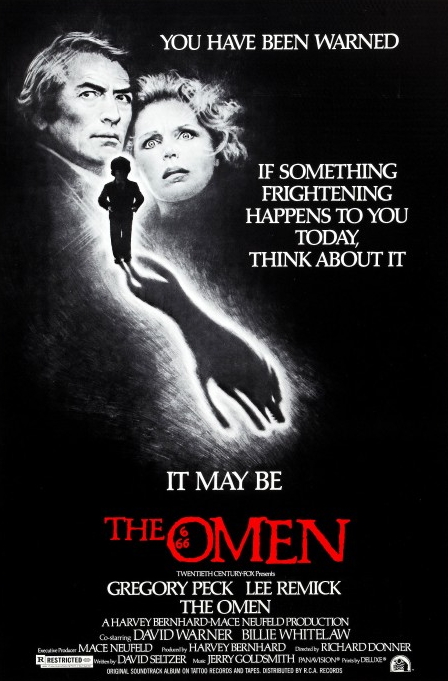SYNOPSIS:
“Robert and Katherine Thorn seem to have it all. They are happily married and he is the US Ambassador to Great Britain, but they want more than to have children. When Katherine has a stillborn child, Robert is approached by a priest at the hospital who suggests that they take a healthy newborn whose mother has just died in childbirth. Without telling his wife he agrees. After relocating to London, strange events – and the ominous warnings of a priest – lead him to believe that the child he took from that Italian hospital is evil incarnate.”
REVIEW:
The seventies were breakthrough years for horror in the cinema. The success of Rosemary’s Baby (1968) had something to do with this, and many good horror films were made right through the seventies, but the biggest commercial breakthrough was that of The Exorcist (1973). It became instant legend, the most popular horror film ever made. It’s efficiently (if not brilliantly) directed by William Friedkin, who takes his time about setting up a family’s normal suburban lifestyle in a nice part of Washington, before destroying the peaceful middle-class oasis by introducing the demonic possession of the young daughter Regan (Linda Blair), a girl on the brink of puberty. Before The Exorcist, most horror films were the product of comparatively small production companies like New World, American International, Hammer and Amicus. After 1973 the big Hollywood studios began jumping on the bandwagon. The Omen (1976) was the other up-market Hollywood horror hit of the period.
The son of American Ambassador Robert Thorn (Gregory Peck) is a changeling, the spawn of Satan. His mother Katherine (Lee Remick) doesn’t know but, when he grows up, he will become the Anti-Christ. Young Damien (Harvey Spencer Stephens) looks sanctimoniously angelic, but throws manic tantrums whenever he goes near a church. His nanny (Holly Palance) commits suicide, and is replaced by the sinister Mrs Baylock (Billie Whitelaw) and her big black dog. Catholic Father Brennan (Patrick Troughton) tries repeatedly to warn Ambassador Thorn about Damien’s mysterious origins, hinting that Damien may not even be human. Afterward, Brennan is impaled and killed by a lightning rod thrown from the roof of a church during a sudden storm.
Learning of Brennan’s death, photographer Keith Jennings (David Warner) begins investigating, noticing shadows in photographs of Brennan and the nanny that seem to presage their bizarre deaths. Photos of Jennings also show these shadows. Jennings shows Thorn the photos and tells him he also believes that Damien is a threat and that he wants to help Thorn. While Thorn is away, Damien knocks Katherine over an upstairs railing to the floor below, causing her to miscarry. Jennings and Thorn travel to Rome to investigate Damien’s birth, only to learn that a fire destroyed the hospital records five years earlier. They then trace Father Spiletto (Martin Benson) to Saint Benedict’s Abbey in Subiaco, where he is recuperating from his injuries. Stricken mute, Spiletto writes the name of an ancient Etruscan cemetery where Damien’s biological mother is buried.
Jennings and Thorn find a jackal carcass in the grave and, in the child’s grave next to it, a child’s skeleton with a shattered skull. These are the remains of Damien’s unnatural ‘mother’ and Thorns’ own child, murdered at birth so that Damien could take his place. Jennings reiterates Brennan’s belief that Damien is the Anti-Christ, whose coming is being supported by a conspiracy of Satanists, when suddenly a pack of wild dogs drive Jennings and Thorn out of the cemetery. Back in London, Baylock murders Katherine by pushing her out of her hospital window. Jennings and Thorn travel to Israel to find archaeologist Carl Bugenhagen (Leo McKern), who explains that if Damien is indeed the Anti-Christ, he will possess a birthmark in the shape of three sixes. Thorn also learns that the only way to kill the Anti-Christ is with seven mystical daggers from Megiddo.
Appalled by the idea of murdering a child, Thorn discards the daggers but, when Jennings tries to retrieve them, he is decapitated by a sheet of window glass sliding off a truck, matching the shadow across his neck which had presaged his death. Returning home, Thorn examines Damien for the birthmark, finding it on the child’s scalp. Baylock attacks him and, in the ensuing struggle, Thorn kills her. He loads Damien and the daggers into a car and drives to the nearest church. Due to his erratic driving, he is followed by the police, who arrive as he is dragging the screaming child to the altar. An officer orders him to raise his hands and stand away. Thorn raises the first dagger and the officer fires his gun. We next see Damien at his father’s funeral, finally, standing next to the President Of The United States.
The idea of a serious motion picture about the Anti-Christ came from Bob Munger, an associate of Hollywood producer Harvey Bernhard, who immediately hired screenwriter David Seltzer to write a screenplay. One full year later the final script was delivered. Despite Bernhard’s claim that Gregory Peck was his first choice to play Ambassador Thorn, a firm offer was first made to Charlton Heston, who turned it down, not wanting to spend an entire winter alone in Europe and was also concerned that the film might appear exploitative if not handled carefully. William Holden was also considered for the role, who turned it down refusing to star in a film about Satan but, two years later, changed his mind to play Thorn’s brother Richard in the sequel Damien: Omen II (1978).
Released theatrically by 20th Century Fox on the 6th June 1976, The Omen received acclaim from critics and audiences alike, taking over US$60 million on its initial release becoming one of the highest-grossing films of the year (Peck was guaranteed 10% of the film’s takings, the highest-paid performance of his career). The film earned two Academy Awards, both for Jerry Goldsmith‘s brilliant soundtrack, his first and only Oscar wins ever (and the only Oscars presentation he didn’t attend!). The film itself is inoffensively nasty, prettily filmed and in good taste, with Peck looking appropriately sober and concerned – but what is it really about?
Subtext 1. Never Adopt.
Subtext 2. Angelic Little Darlings Have Mischief In Mind.
Subtext 3. Evil Is Foreign And Does Not Grow From Within The USA.
Bourgeois values are not threatened by the film in any way except perhaps in the secret pleasure the audience derives from the bad kid’s victory at the end, and the suggestion that all will not be well with the Presidency, but even that was a commonplace American thought in 1976. This glossy, glazed attempt to rework the traditional horror picture (big stars, nice photography) for a respectable audience was commercially successful but, as a film, it doesn’t really amount to much.
Damien: Omen II (1978) was cheaper and much more lively. It was certainly gorier, as Damien (Jonathan Scott-Taylor), now a handsome teenage boy adopted by a politically powerful American family, grows into knowledge of his powers, and polishes off any sign of resistance (crows peck out eyes, elevator accidents cut victims in half and, in the most inventive scene, a man drowns in a frozen lake, struggling wildly just beneath the ice unable to break through). As a fantasy the film is mediocre at best, the most impressive sequence being when Damien beats up a bully at military school using his telekinetic powers. As an anthology of murders, it gives devotees of extravagant demise their money’s worth. Indeed, the film points the way forward to such exploitation pictures as Friday The 13th (1980), whose only reason for being is the presentation of successive homicides.
Omen III: The Final Conflict (1981) is stunningly inadequate. Damien Thorn (Sam Neill), now the United States Ambassador in London, sets about killing babies to prevent the Second Coming of Christ, an event that ends the film quite farcically. A terrible script leaves otherwise dependable actor Neill quite helpless, and the statutory satanic murders are over-contrived and without any shock value whatsoever (let alone a point). The franchise ended not with a bang but a whimper, with Omen IV: The Awakening (1991), a made-for-television movie that served as the fourth and final film in the original franchise. Essentially a re-imagining of the original scenario, it features a Congressman (Michael Woods) with a demonic daughter named Delia (Asia Vieira). Harvey Bernhard, who produced the first three films, felt there could be more done for it, and the movie had an overwhelmingly negative reception from critics.
Exactly thirty years later a remake was released entitled The Omen: 666 (2006) directed by John Moore and starring Liev Schreiber, Julia Stiles and Mia Farrow. It was almost universally disliked: James Berardnelli: “On every level, The Omen isn’t just bad filmmaking, it’s bad storytelling.” Rolling Stone: “Not since Gus Van Sant inexplicably directed a shot-by-shot remake of Psycho (1998) has a thriller been copied with so little point or impact.” BBC: “While arguably better than its source, can’t help but feel a bit stale.” Eric D. Snider: “This film is for people who’ve never seen the original, and who are easily scared by mediocre horror films.” Empire Magazine: “Competently made, and enjoyably played. But you do really end up wondering what the point was. Cinematic déjà vu is the most likely response.”
Making its debut next month is the new cable television series Damien (2016) produced by the Arts & Entertainment Network (A&E). The story follows the adult life of Damien Thorn (Bradley James) is now a thirty-year-old war photographer who has forgotten his Satanic past, and must face his true identity. Ann Rutledge (Barbara Hershey) has protected Damien all his life, and helps him embrace his Anti-Christ side. As with all reboots, remakes, sequels and re-imaginings, I shall not stress, but simply hope for the best and expect the worst. I suggest you do the same. Speaking of which, whether you like it or not, I’ll be back next week with another bargain-basement B-grader to thrill you, chill you, and fill you with swill with…Horror News! Toodles!
The Omen (1976)
 Horror News | HNN Official Site | Horror Movies,Trailers, Reviews
Horror News | HNN Official Site | Horror Movies,Trailers, Reviews


















I love ‘The Omen’, I think it contains enough originality and real horror in both concept and execution to stand tall as a classic in the genre. Richard Donner has always been a superb, unpretentious story teller, I can only think of one film in his career that didn’t work (Timeline). The remake was unjustified and terrible.
Big fan of Donner’s work – his edition of Superman II is certainly superior – but his TV work was darn good too, directing some episodes of the Steve McQueen western serial Wanted: Dead or Alive and the Chuck Connors western The Rifleman. In his early career as a director he worked on TV commercials and over twenty-five television series including Have Gun Will Travel, The Fugitive, Combat!, Get Smart, The Man from UNCLE, The Wild Wild West, Gilligan’s Island, Kojak, Tales from the Crypt and The Twilight Zone (most notably the famous Nightmare At 20,000 Feet starring William Shatner and From Agnes With Love starring Wally Cox), as well as the hilarious serial Danger Island from the children’s program The Banana Splits.